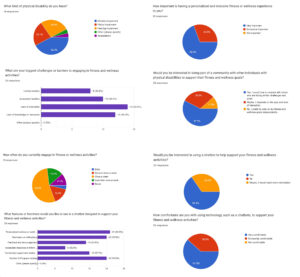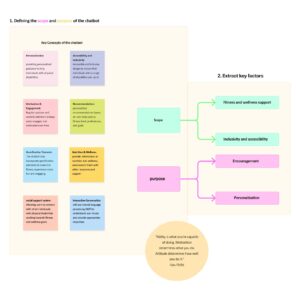Premise
Using chatbot technology to support and motivate individuals with physical disabilities to engage in fitness and wellness activities
Synopsis
People with physical disabilities often face various challenges in maintaining a healthy and active lifestyle, including limited access to sports facilities, difficulty in finding the motivation to exercise regularly, and a lack of personalized fitness plans. Without access to appropriate resources and support, it can be difficult for them to engage in regular physical activity and maintain a healthy lifestyle, leading to a higher risk of chronic diseases. Therefore, a more regular and personalized fitness plan and proper guidance and motivation are necessary to address their challenges and improve their overall health and well-being. Although the fitness industry has made efforts to include people with physical disabilities, they continue to encounter various challenges and may feel excluded or overlooked. While there have been advancements in technology to support individuals with disabilities in leading healthy lifestyles, there has been limited focus on incorporating chatbots into this field. This project aims to discover how chatbot technology can support and motivate people with physical disabilities to participate in physical activity and wellness by offering them a personalized and inclusive experience.
SUBSTANTIATION
Individuals with physical disabilities are particularly more vulnerable to developing chronic diseases and other health issues than others, emphasizing the importance of regular physical activity for their well-being (Carroll et al., 2014). People with physical disabilities can benefit from regular physical activity by improving their mood, increasing their self-esteem, and building social connections (Sharon-David et al., 2021). Despite the benefits of regular exercise for this group, it may not always be a choice for them due to various challenges or restrictions (Lola et al., 2021). People with physical disabilities need personalized guidance and assistance to achieve their fitness and health goals (Devandas Aguilar, 2017). Moreover, according to a study by Villanueva-Flores et al. (2017), many individuals with physical disabilities have reported feeling neglected or excluded in the fitness community. The lack of support in these areas can affect their health and lead to an inactive lifestyle (Mckenzie et al., 2021). The development of technology has made it possible to develop new and creative methods to motivate and assist individuals with physical disabilities in maintaining a workout routine and engaging in physical activities (Bricout et al., 2021). Several applications have been created to help individuals with physical disabilities lead healthy lifestyles; however, there is still room for improvement, particularly in motivating this group to engage in fitness activities and providing personalized and accessible solutions for promoting physical activity and health (Stratton et al., 2020). AI Chatbots have the potential to support those with physical disabilities in maintaining a healthy lifestyle, particularly in the context of motivation, personalized workout plans, and healthier nutrition (Rzepka et al., 2021).AI chatbots can be customized to meet the particular needs and preferences of people with physical disabilities, encouraging users to adjust their exercise routines and developing long-lasting, supportive connections to help maintain healthy behavior (Zhang et al., 2020). A recent study found that over half of the chatbots designed to promote physical activity and healthy lifestyles successfully inspired and encouraged users to make significant changes, indicating that chatbots may help create positive habits in users (Rahmanti et al., 2022).In conclusion, developing an AI chatbot sounds like a promising solution to help individuals with physical disabilities overcome the challenges of maintaining a healthy lifestyle and engaging in fitness. By providing personalized support, motivation, and guidance on physical activity and nutrition, this technology has the capacity to facilitate positive behavioral changes and improve overall well-being.
Project
The project benefited from the Chatbot workshop, which helped develop the ” FitBot ” chatbot using the Landbot app. Before building the chatbot, a survey was conducted to gather information on the needs and challenges of people with physical disabilities related to fitness and to identify desired features for the chatbot. The survey was shared online in various communities for people with physical disabilities and received 26 responses.
Survey Findings and insights
Most participants assumed personalized and inclusive experiences were necessary and expressed interest in a community to support their goals. Desired chatbot features included personalized plans, reminders/notifications, feedback, accessible resources, community support, and progress tracking. Participants shared experiences of facing challenges and feeling overlooked/excluded due to their disabilities.

Prototyping

Iteration 1
The first iteration of the chatbot design includes a welcome message and asks users questions about their physical health, preferred exercise frequency, type of exercise they would like to try, and fitness goals. It also collects information about foods to include or avoid for a personalized nutrition plan. With this information, the chatbot generates a customized workout and nutrition plan for the user and also allows them to connect with a community working towards similar fitness goals. The chatbot aims to collect essential information about the user’s physical health and generate a tailored plan to align with their fitness goals.

User testing
Based on the user testing insights gathered from two individuals in the first iteration, several areas of improvement were identified for the chatbot. The chatbot was found to be easy to navigate and user-friendly, but adding more personalized features, more clarity on data privacy, and asking about dietary preferences and some sub-questions about the kind of disability that the user have could make it more effective in helping users achieve their fitness goals. Motivation, positive feedback, and natural language were suggested to make the chatbot more approachable. In the second iteration, the chatbot could be improved by incorporating critical features such as personalization, asking multiple-choice questions to determine what motivates the user, and addressing data privacy concerns.
Iteration 2
In the second iteration of the chatbot design, several new features were added to improve the user experience and make the chatbot more effective. These features include asking about food allergies before providing a nutrition plan, asking a multiple-choice question to understand user motivation, addressing privacy concerns by providing more information on how user data will be used, asking more questions about disabilities to recommend suitable exercises, incorporating motivation sources recommending workout plans based on preferences of people with similar disabilities, avoiding the use of the user’s name in each step to sound less robotic, and improving the user interface.

User testing
During the second iteration of the chatbot design, it was tested with one user and one stakeholder to gather insights for further improvements in the third iteration. The user was satisfied with the chatbot’s easy-to-understand prompts and appreciated the personalized and inclusive workout plan recommendations. However, the user provided some feedback to improve the chatbot’s functionality, recommending more comprehensive guidance beyond a simple exercise list. To enhance the user experience, the user suggested labeling the multiple-choice options and including an “I don’t know” option. Moreover, the user recommended inquiring about users’ workout preferences and offering tutorial videos for some exercises to further enhance the chatbot’s effectiveness. The stakeholder identified the need for specialized fitness equipment and incorporate engagement strategies like regular notifications, incentives, and fostering a sense of community among users. Additionally, the stakeholder suggested inquiring about past attempts to reach fitness goals and reasons for quitting to prevent users from quitting.
Iteration 3
For the third iteration of the chatbot, several adjustments were made to improve user experience and engagement. To make the plan more realistic, any necessary I don’t know options were added, and the chatbot now asks the user if they have ever tried to participate in a fitness activity and failed, followed by asking for the reason. To better customize the plan for the user, they are asked whether they want to work out at home or the gym, considering any equipment or space limitations. Additionally, related music playlists are offered to enhance the workout experience, and tutorial videos are provided to guide the user on specific plans. To increase engagement, gamification strategies such as monthly challenges have also been incorporated into the chatbot. These adjustments aim to provide a more personalized and motivating experience for the user, making it easier for them to achieve their fitness goals.

Conclusion
The project aimed at addressing the needs and challenges of people with physical disabilities related to fitness. To understand these needs and challenges, a survey was conducted to identify the features that users with physical disabilities wanted in a fitness chatbot and their challenges in engaging in fitness and wellness activities. Based on the survey results, a chatbot was developed that provides personalized workout and nutrition plans, reminders and notifications, feedback and encouragement, and community support and motivation. The chatbot’s design aimed to collect essential information about the user’s physical health and fitness goals and generate a tailored workout and nutrition plan that aligns with those goals. This personalized approach helps users with physical disabilities to achieve their fitness goals effectively and efficiently. The chatbot’s design went through several iterations based on user testing to improve its functionality and user experience. Feedback from users was used to enhance the chatbot’s design and make it more user-friendly. In the future, the chatbot can connect to a workout and nutrition plan database to provide more accurate recommendations. Further research could also determine optimal feedback and motivational strategies for promoting physical activity and healthy habits among users with physical disabilities.
References
Rahmanti, A. R., Yang, H. C., Bintoro, B. S., Nursetyo, A. A., Muhtar, M. S., Syed-Abdul, S., & Li, Y. (2022). SlimMe, a Chatbot With Artificial Empathy for Personal Weight Management: System Design and Finding. Frontiers in Nutrition, 9. https://doi.org/10.3389/fnut.2022.870775
Stratton, C., Kadakia, S., Balikuddembe, J. K., Peterson, M., Hajjioui, A., Cooper, R., Hong, B. Y., Pandiyan, U., Muñoz-Velasco, L. P., Joseph, J., Krassioukov, A., Tripathi, D. R., & Tuakli-Wosornu, Y. A. (2020). Access denied: the shortage of digitized fitness resources for people with disabilities. Disability and Rehabilitation, 44(13), 3301–3303. https://doi.org/10.1080/09638288.2020.1854873
McKenzie, G., Willis, C. P., & Shields, N. (2021). Barriers and facilitators of physical activity participation for young people and adults with childhood‐onset physical disability: a mixed methods systematic review. Developmental Medicine & Child Neurology, 63(8), 914–924. https://doi.org/10.1111/dmcn.14830
Devandas Aguilar, C. (2017). Social protection and persons with disabilities. International Social Security Review, 70(4), 45–65. https://doi.org/10.1111/issr.12152
Villanueva-Flores, M., Valle, R., & Bornay-Barrachina, M. (2017). Perceptions of discrimination and distributive injustice among people with physical disabilities. Personnel Review, 46(3), 680–698. https://doi.org/10.1108/pr-04-2015-0098
Richardson, E. V., Smith, B., & Papathomas, A. (2017). Crossing boundaries: The perceived impact of disabled fitness instructors in the gym. Psychology of Sport and Exercise, 29, 84–92. https://doi.org/10.1016/j.psychsport.2016.12.006
Rzepka, C., Berger, B., & Hess, T. (2021). Voice Assistant vs. Chatbot – Examining the Fit Between Conversational Agents’ Interaction Modalities and Information Search Tasks. Information Systems Frontiers, 24(3), 839–856. https://doi.org/10.1007/s10796-021-10226-5
Church, T. (2011). Exercise in Obesity, Metabolic Syndrome, and Diabetes. Progress in Cardiovascular Diseases, 53(6), 412–418. https://doi.org/10.1016/j.pcad.2011.03.013
Zhang, J., Oh, Y. J., Lange, P., Yu, Z., & Fukuoka, Y. (2020). Artificial Intelligence Chatbot Behavior Change Model for Designing Artificial Intelligence Chatbots to Promote Physical Activity and a Healthy Diet: Viewpoint. Journal of Medical Internet Research, 22(9), e22845. https://doi.org/10.2196/22845